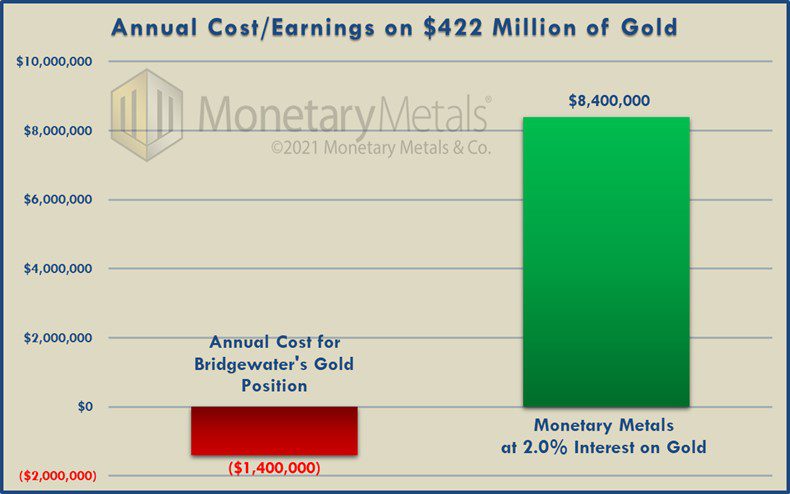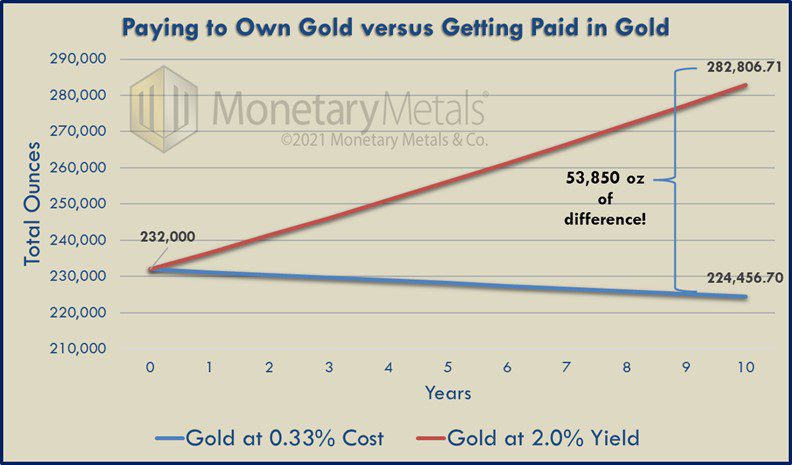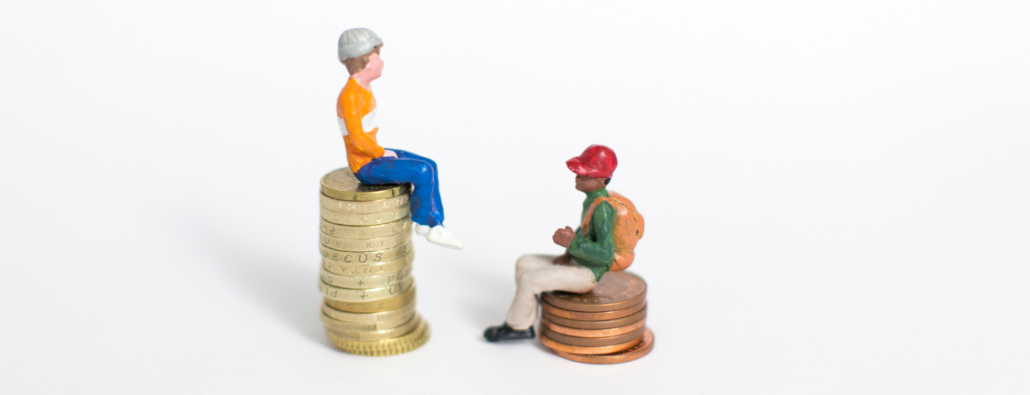To listen to the audio version of this article click here
Ray Dalio made waves earlier this year when he acknowledged that Bridgewater bought an undisclosed amount of bitcoin. In a recent interview, however, Dalio made it clear that his love for gold is still greater.
“If you put a gun to my head, and you said, ‘I can only have one,’” says Dalio. “I would choose gold.” (Source of Quote)
We agree with Dalio’s decision to choose gold over bitcoin, but we think it’s high time that he explores some better ways of owning gold.
Ray Dalio’s History of Buying Gold
Dalio and Bridgewater have been noted buyers of gold over the years. Most recently they increased their gold position in the winter of 2019 just before the pandemic hit. The price exploded as the pandemic grew.
While Bridgewater has achieved massive gains in dollars in recent years, it is still paying to own that gold via the expense ratio of its ETF holdings. When the gold price goes up, the cost to store that metal goes up as well. And this is a recurring annual cost.
Expense Ratios are a Negative Yield for Gold
As of their latest 13F report (6/30/2021), Bridgewater owns about $422 Million of gold. About $276 million in GLD and $146 Million in IAU. GLD’s expense ratio is 0.40% and IAU’s expense ratio is 0.25%. Taken together that’s an effective rate of 0.33%. Translated into dollars, this means Bridgewater is paying about $1.4 Million per year to own this gold.
Despite the dollar gains on their position, Bridgewater owns a negative-yielding asset. If Bridgewater were to redeem their GLD shares for actual physical gold ounces today, they’d have less ounces than when they started. And their redeemable ounces will continue to dwindle going forward.
I don’t want to downplay the wisdom to buy gold. But, Dalio and the rest of the world need to know that gold doesn’t have to be a negative-yielding asset anymore! Gold is a capital asset, and capital assets should be deployed productively to earn a yield.
A Better Way to Invest in Gold
Instead of investors paying to own gold, Monetary Metals has been paying investors interest on gold, in gold since 2016. You can earn interest on gold to the tune of 2.0 to 4.5% annually. Not only that–there’s zero storage and insurance fees!
2% interest might not seem like a lot, but when you start working with large numbers over time, the difference between earning 2% on your gold vs paying 0.33% is as stark as night and day.
In Dalio and Bridgewater’s case, this would mean that instead of losing $1.4 million annually due to gold storage fees, their $422 million gold investment could be earning them $8.4 million each year. That’s nearly a $10 million net improvement.
This isn’t the full impact of course. Since both the cost to store metal, and the interest you could earn on your gold recur annually, you have to take into account the effect of compounding interest (or cost).
$422 Million in gold equals just under 232,000 ounces, assuming a gold price of $1,820. If Bridgewater were to put their gold to work at 2% per year for 10 years with Monetary Metals, they would end up with just under 283,000 oz, a gain of about 22% on their metal. Measured in dollars at the same gold price, that’s $92.5 million. If they continue paying to own their gold, they end up with about 7,543 less ounces. A loss of about 3.25%, or $13.7 million. Over a decade, the Monetary Metals’ difference is 53,850 oz or over $100 million.
Dalio, Bridgewater, and you could level up your gold by treating it not just like an ordinary commodity, but as a yield-generating capital asset.


 :
:




“Taken together that’s an effective rate of 0.33%.”
Of course, you cannot do that.
$422 Million at 0.33% is not equal to $276 million at 0.40% + $146 Million at 0.25%
And to be honest, the spread is due to the difference of risk between an “asset” and a debt.
(Yes, GLD has a counterparty risk too.)
Hello Anonymous,
Thank you for reading and for commenting!
I understand your point about the math. However, because Bridgewater is continuously changing their positions we weren’t looking to get a precise figure for their holding cost in Q2 of 2021. We were looking more for an approximate ongoing rate for those costs based on their most recent publicly reported positioning. Hence the language of “Bridgewater is paying about $1.4 Million per year.”
Your point about spread is well taken!
That’s precisely what we’ve introduced with our products and marketplace. We offer true gold investments which pay a return on gold, in gold. And of course there’s no return without some risk.
In this article we have our True Gold Leases in mind, where 2% is indicative of the lower end of our yield range for leases. Other leases have paid as high as 4.5% per annum. You might be interested in our paper The Risk Return Spectrum in Gold which goes into further detail about the risks of our gold leases and gold bonds and how they compare to other gold investments. Here’s the link: https://monetary-metals.s3.amazonaws.com/public/The+Risk-Return+Spectrum+in+Gold.pdf